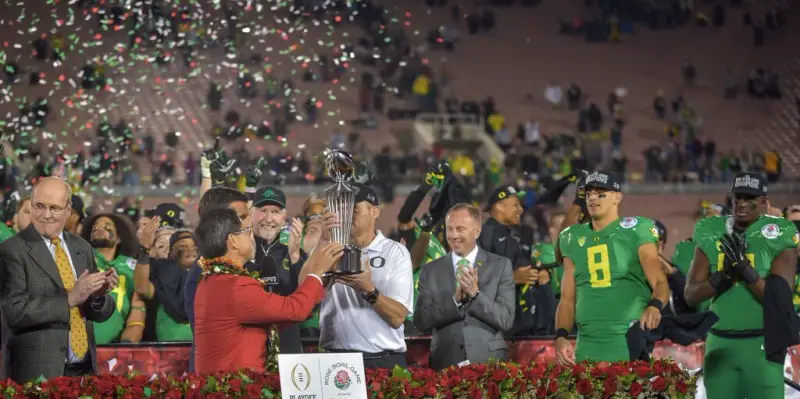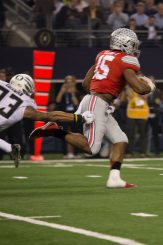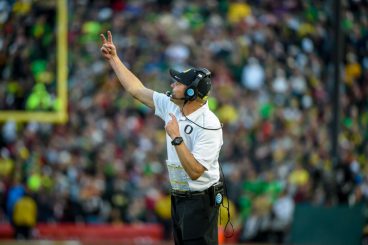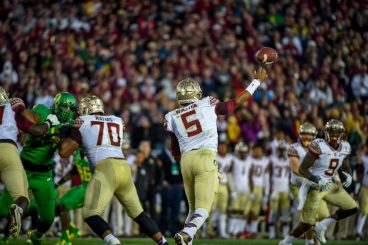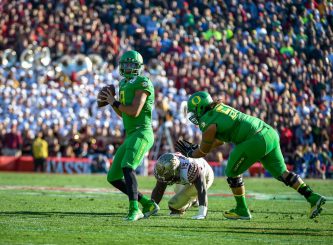No college football program faces a greater disparity between reality and reputation than Oregon.
One would think that having the nation’s highest winning percentage over the past five seasons in what could easily be argued as college football’s deepest conference would warrant some respect. And, in fairness, it has to a certain extent – the Ducks do ultimately earn the rankings they deserve, and they are generally considered one of the teams to beat in the Pac-12.
Still, the myths of Oregon football persist and perhaps the most widespread states that the Ducks are “soft.” The team shed this image for all of two weeks after a 59-20 shellacking of Florida State in the Rose Bowl, but things went right back to “normal” when it fell to Ohio State in the national title game.
Ezekiel Elliot rushed for 246 yards on 36 carries, which seemed to further prove that Oregon can’t hang with a traditional powerhouse. Forget the fact that he managed 230 yards on only 20 carries against Alabama – SEC poster child and perpetual defensive juggernaut – two weeks earlier. Don’t think, just know: Oregon is soft.
The Ohio State game marked the team’s second loss in a national championship game in five years. As a result, there has been a rebirth of a another, similar myth surrounding Oregon football.
“The Ducks can’t win in big games.”
Unlike the previous myth, this one is tangible. It can be studied. When it is, the artificial veil that is Oregon’s faulty reputation comes tumbling down, and the Ducks can be seen for who they really are.
To see how Oregon has actually fared in big games, I examined the game results of 15 of college football’s best programs over the past five years against teams that finished ranked in the Top 25. These are Alabama, Auburn, Baylor, Clemson, Florida State, Georgia, LSU, Michigan State, Ohio State, Oklahoma, Stanford, TCU, USC, Wisconsin and — the Ducks.
There were no specific criteria for the programs that made the list, so it is arbitrary to a certain extent. However, it does provide a strong representation of the top programs since 2010. Of these programs, only six had a winning percentage higher than .500 in those games. As it turns out, Oregon actually has the highest winning percentage (.631) against ranked teams since the beginning of 2010. The Ducks are trailed closely by Alabama (.609) and Ohio State (.600).
It should be mentioned that the SEC teams on the list have, in general, played more games against teams that finished ranked in the Top 25. Alabama, for example, has played 23 while Oregon has played 19. However, the SEC’s higher rankings are to some extent due to circular logic: teams are ranked higher because they are in the SEC and the SEC is ranked higher because it has the most ranked teams. Additionally, the quality of the wins is as important as the quantity.
Oregon also has the highest average margin of victory against ranked teams over that span with 11.4 ppg. To put that into perspective, the next team on the list is Alabama with 8.2. Because the Ducks have the highest winning percentage, this certainly makes sense. However, they also have the highest average margin of victory in wins against ranked teams (22.8). Oklahoma is next with 18.8.
Oregon also stands out in terms of the strength of these ranked opponents. Of the 15 programs listed, the Ducks (10.6) trail only LSU (9.7) and Alabama (10.3) in terms of their opponents’ average rank in the games examined.
Clearly, the program can and does win big games. In fact, the Ducks do it more (and more convincingly) than any other elite team. We know they can win, and now they’ve proven that they have become the nation’s best against the best.
College football is widely considered to be a game where winning is everything. However, it has become clear that means only a certain type of winning. Otherwise, Oregon, the program with the highest winning percentage over the past five years, would be objectively considered the game’s top dog.
As the 2015 NFL Draft came and went, Jameis Winston, the outgoing, traditional pocket passer, and Marcus Mariota, the silent dual-threat quarterback, provided fans with a perfect microcosm of the sport’s unwritten rules. Forget the 18 interceptions he threw in 2014. With a career record of 26-1, all Winston did was win, and he was taken with the first overall selection by Tampa Bay.
But Mariota won too — a lot. He recorded a 36-5 career record as a starter, and happily provided that lone blemish on Winston’s record. It just didn’t look the way it should have. For Winston, a win was a win. For Mariota, a win was the result of trickery that stemmed from a gimmicky system.
In the context of college football’s traditional dogma, a team’s reputation hinges on a distinction between the familiar and unfamiliar as much as it does between success and failure.
A team that can out-hustle you instead of out-power you is little more than an unwelcome thought experiment, while the idea of a successful quarterback that can run and throw simply returns a syntax error.
Like anything else, college football is often uncomfortable with change. If you are different, you can’t just win — you need to beat tradition. With both the highest win percentage overall and the highest win percentage against ranked teams over the last five years, Oregon is well on its way to doing just that.
Top Photo by Craig Strobeck
Related Articles:
Joey Holland graduated from the University of Oregon in 2013, majoring in History. He played several sports in high school, though football remains his passion. He has yet to miss a single Oregon Ducks home football game during his time in Eugene. Joey has written previously for Bleacher Report and Football Nation.
Joey welcomes your feedback.

